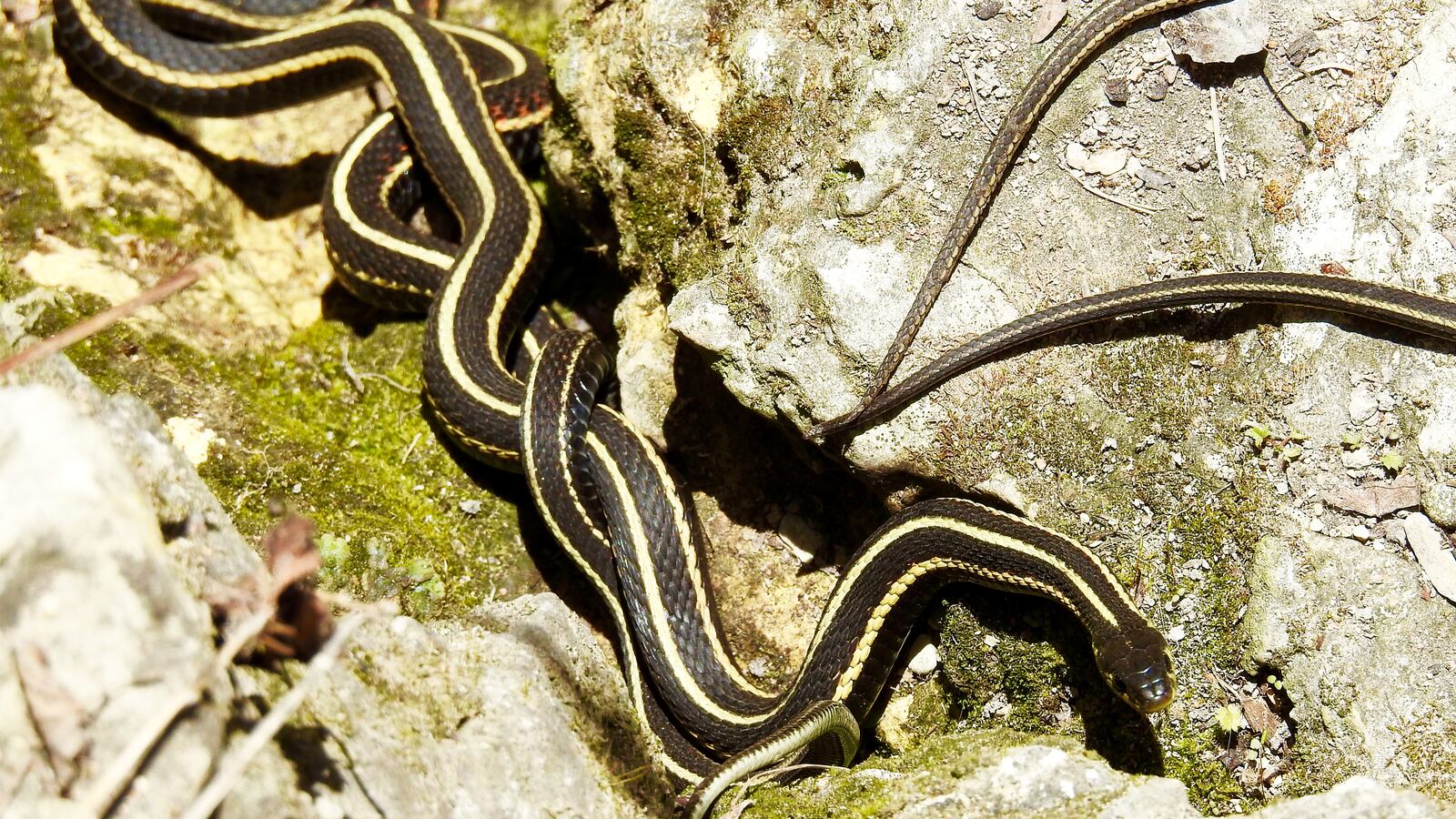The tangle of smooth, slender bodies writhes as one, tiny heads emerging from the reproductive battle to eyeball the competition with beady, expressionless eyes as tapered tails flick toward the heavens. For every red-sided garter snake that doesn’t have the stamina to carry on and slinks away, a new one arrives to slither excitedly right into the thick of the mating ball, searching for the lone female who has been emitting come hither pheromones and taking stock of her suitors.
Standing on a viewing platform above den two, I gawk as a half-dozen mating balls form, roll through the dirt, slide down rocky hills and eventually dissolve. During the week, there are film crews, herpetologists, and school groups here. But it’s the May long weekend and so while I try to get video footage, this place is family central and full of parents who are carefully leaving the sex part out of the explanation and just trying to teach squealing kids that snakes aren’t slimy, evil, or disgusting.
This annual spring orgy in the Narcisse Snake Dens in rural Manitoba, Canada, is the largest gathering of snakes anywhere on the planet. Anywhere from 75,000 to 150,000 normally anti-social garter snakes come out of their communal winter dens every April and May and congregate for a few intense weeks of mating.
“This is one of the natural wonders of the world,” Manitoba Conservation interpreter Gary Chikousky tells me. “The main thing people look for is mating balls. It’s a sight to see.”

He scoops up a friendly snake that has popped out from under the fence and shows how to let it move from hand to hand until it calms down and realizes it’s safe. After patiently waiting for a bunch of girls to hold or at least stroke the snake, I finally get my turn. I was that weird kid who played with garter snakes at the cottage. I’d catch and name them, coax them into cardboard-box homes, and soon give up turning them into pets.
Don’t kiss snakes, Chikousky warns, because of the chance of salmonella. Be careful of the foul-smelling yellow secretion they can release through their skin when they feel threatened. Luckily the beauty in my hands doesn’t “musk” but I still don’t give him a smooch.
We’re 90 minutes north of Winnipeg, Manitoba’s capital city, in the Narcisse Wildlife Management Area. The 11,882-hectare area is protected partly because of the multitude of snakes that den in the limestone bedrock over the winter, mate in the spring, and then disperse up to 12 miles throughout the open grasslands, aspen forest and wetlands to summer feeding grounds before returning to the dens in fall.
I come early one Saturday and nab a prime parking spot before ducking into an outhouse and then studying the map of four snake dens connected by nearly two miles of trails. Interpretive signs along the path tell you almost everything you want to know.

"Ne Pas Enlever Les Serpents De La Propriété"
JENNIFER BAINTo survive harsh winters, non-venomous red-sided garter snakes, plus some western plains garter snakes, use fractures in the underlying limestone bedrock to access caverns below the frost line and above the water table. When the spring sun starts to warm the rocks, they slowly emerge. The males are first out and congregate by the entrance for the chance to mate. As the females slowly emerge a few at a time, sluggish but excited males chase them and form mating balls, which aren’t really ball-shaped and can involve two to 100 snakes.
“Do not handle the mating ball,” illustrated signs warn at every den. Unlike a smaller orgy at Fort Livingstone National Historic Site in Pelly, Saskatchewan, the Narcisse pits are fenced to give the snakes some personal space.
“Pick up one snake at a time,” urges a sign showing a snake nestled in the palm of a hand.
“Leave the female snakes alone! (The big and fat ones),” warns another.

Do's and Don't's of Handling Snakes
JENNIFER BAINNo need to worry about the sexual swarmings because the females have switched on their mating pheromones. They pick who to align their bodies with before “mating occurs” and they can slither away to summer feeding grounds, leaving the frantic band of suitors to pounce on the next snake woman.
That’s too vague for me so I press Chikousky for the gory details. Male snakes will bump their chins against the back of the female’s head and body and crawl all over her attempting to intertwine tails. They need the tails to meet at the cloaca, an opening for urinary, digestive and reproductive functions. Then the lucky male will extend and insert one of his two penises (called hemipenes) and release his sperm plus a temporary copulatory plug.
“Sometimes it can take minutes for the ball to form and the female to choose a mate,” Chikousky explains, “and sometimes it can take hours. During the peak of emergence, you can’t see the ground for all the snakes.”

The copulatory plugs soon dissolve, he goes on to say, and so the female snake can collect sperm from several males. She can retain sperm for up to five years and decide if and when to fertilize it. Unlike most snakes, garters give birth to sometimes finger-sized babies (not eggs) that take off immediately and learn to hunt insects, worms, minnows, frogs, toads, tadpoles, leeches and eventually baby mice and nestling birds.
These wild snakes can live up to 14 years, if they can evade their main predator, the crow that pecks out their livers and leaves the rest for scavengers. “Do not remove snakes from the property,” warn anti-poaching signs. It’s illegal to harm, harass, or remove snakes.
Sandeep Singh, originally from India but living in Winnipeg, has brought his dad Jaspal Singh to see the spectacle. “In India, snakes are big and dangerous and whenever we see them, people like to kill them. Here they will run away when they see us. My friend in India told me this was the largest gathering of snakes in the world, so that’s why we came. I’ve never seen so many snakes in my life.”

Jaspal and Sandeep Singh
JENNIFER BAINChikousky isn’t wearing it today, but tells me he has a commemorative shirt from 2008 when U-Haul came out to unveil the Narcisse snakes graphic it had splayed across moving vans for its Venture Across Canada campaign to highlight little-known facts.
“Now, people all over North America will have the privilege of seeing and learning more about the red-sided garter snake,” U-Haul Co. of Central Canada president Real Faucher said at the time. “These often-hidden snakes of Manitoba can now be seen year-round as they travel with U-Haul across North America on the sides of 1,450 moving vans."
It’s 11 years later but when I troll through a few U-Haul locations in Winnipeg, I actually find and photograph one of the vans. The colorful graphic doesn’t show lurid mating balls, just bright-eyed snakes with erect heads and forked tongues under the words “Manitoba reptile ritual.”

U-Haul Snakes
JENNIFER BAINThis wacky natural phenomenon/tourist attraction still flies under the radar. Hardly anybody knows that the Manitoba Museum has an impressive diorama of a den featuring amorous snakes made from hot glue.
“The snake dens are one of those things that people are amazed they haven’t heard of, but when they do hear about it, they go see it,” says Anya Moodie-Foster, the museum’s learning and engagement supervisor. “I went just once, for Mother’s Day two years ago. One of my daughters was very keen and the others were not. They did not ask me to go back this year. They just made me breakfast in bed.”
Manitobans can head out to the dens on a whim, but visitors from around the globe must time their trips carefully. Mother’s Day usually has the most impressive display of snakes, but this year spring came late and so did the snakes. Half the fun of snake-seeing is taking time to explore the Interlake region.
Narcisse itself is just a collection of homes, so I stop in the hamlet of Inwood at the giant roadside statue known as the “S-sam and S-sara Garter Snakes.” The Highway 17 Service in Inwood sells a postcard of a single, coiled snake, and a shirt that says “Our paths crossed at Narcisse Snake Dens,” but that’s the only snake merchandise I can find. Rosie’s Café next to the gas station makes a mean plate of perogies for people who don’t pack picnics. The fabulously retro King Buck Inn in Poplarfield, another diner/convenience store, prides itself on its homemade pie. The Me & My Dogs food cart often sets up at the Narcisse Snake Dens parking lot.

Manitoba Conservation interpreter Gary Chikousky
JENNIFER BAINAfter a night in Gimli (Manitoba’s New Iceland and a beach town), I make a return visit to the snake dens. This time it’s Sunday and a little warmer, 55 Fahrenheit, and the parking lot is overflowing so cars are lining Highway 17. For years, this road was dangerously slippery from the crushed bodies of thousands of migrating snakes. Now short mesh fences guide the snakes into small tunnels under the road.
Doug O’Neill, who just co-wrote 110 Nature Hot Spots in Manitoba and Saskatchewan with Jenn Smith Nelson and devoted two pages to the Narcisse Snake Dens, tells me he has been here twice even though he’s not overly fond of snakes. “In the spring it’s about full-on mating, but in the fall it felt like a caravan of them just returning to the dens. My sense was one of movement. That weirded me out—the whole slithering sensation.”
I want to go back and see this—snakes following pheromone trails back to the dens and then sunning themselves in the rocky pits for a final few precious days above ground, more concerned about the long, dark and crowded hibernation-like state of brumation to come than sex.







